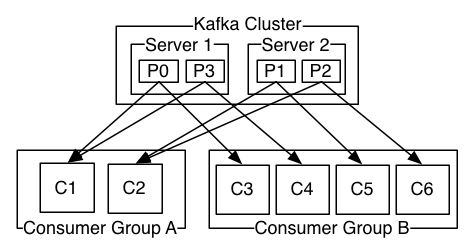1.1 Introduction中 Consumers官网剖析(博主推荐)
不多说,直接上干货!
一切来源于官网
http://kafka.apache.org/documentation/

Consumers
消费者(Consumers)
Consumers label themselves with a consumer group name, and each record published to a topic is delivered to one consumer instance within each subscribing consumer group. Consumer instances can be in separate processes or on separate machines.
通常来讲,消息模型可以分为两种, 队列和发布-订阅式。
队列的处理方式是 一组消费者从服务器读取消息,一条消息只有其中的一个消费者来处理。
在发布-订阅模型中,消息被广播给所有的消费者,接收到消息的消费者都可以处理此消息。
Kafka为这两种模型提供了单一的消费者抽象模型: 消费者组 (consumer group)。
消费者用一个消费者组名标记自己。 一个发布在Topic上消息被分发给此消费者组中的一个消费者。
If all the consumer instances have the same consumer group, then the records will effectively be load balanced over the consumer instances.
If all the consumer instances have different consumer groups, then each record will be broadcast to all the consumer processes.
假如所有的消费者都在一个组中,那么这就变成了queue模型。
假如所有的消费者都在不同的组中,那么就完全变成了发布-订阅模型。
更通用的, 我们可以创建一些消费者组作为逻辑上的订阅者。
每个组包含数目不等的消费者, 一个组内多个消费者可以用来扩展性能和容错。正如下图所示:

A two server Kafka cluster hosting four partitions (P0-P3) with two consumer groups. Consumer group A has two consumer instances and group B has four.
2个kafka集群托管4个分区(P0-P3),2个消费者组,消费组A有2个消费者实例,消费组B有4个。
More commonly, however, we have found that topics have a small number of consumer groups, one for each "logical subscriber". Each group is composed of many consumer instances for scalability and fault tolerance. This is nothing more than publish-subscribe semantics where the subscriber is a cluster of consumers instead of a single process.
The way consumption is implemented in Kafka is by dividing up the partitions in the log over the consumer instances so that each instance is the exclusive consumer of a "fair share" of partitions at any point in time. This process of maintaining membership in the group is handled by the Kafka protocol dynamically. If new instances join the group they will take over some partitions from other members of the group; if an instance dies, its partitions will be distributed to the remaining instances.
Kafka only provides a total order over records within a partition, not between different partitions in a topic. Per-partition ordering combined with the ability to partition data by key is sufficient for most applications. However, if you require a total order over records this can be achieved with a topic that has only one partition, though this will mean only one consumer process per consumer group.
正像传统的消息系统一样,Kafka保证消息的顺序不变。
再详细扯几句。传统的队列模型保持消息,并且保证它们的先后顺序不变。
但是, 尽管服务器保证了消息的顺序,消息还是异步的发送给各个消费者,消费者收到消息的先后顺序不能保证了。
这也意味着并行消费将不能保证消息的先后顺序。用过传统的消息系统的同学肯定清楚,消息的顺序处理很让人头痛。
如果只让一个消费者处理消息,又违背了并行处理的初衷。 在这一点上Kafka做的更好,尽管并没有完全解决上述问题。
Kafka采用了一种分而治之的策略:分区。
因为Topic分区中消息只能由消费者组中的唯一一个消费者处理,所以消息肯定是按照先后顺序进行处理的。
但是它也仅仅是保证Topic的一个分区顺序处理,不能保证跨分区的消息先后处理顺序。
所以,如果你想要顺序的处理Topic的所有消息,那就只提供一个分区。
作者:大数据和人工智能躺过的坑
出处:http://www.cnblogs.com/zlslch/
本文版权归作者和博客园共有,欢迎转载,但未经作者同意必须保留此段声明,且在文章页面明显位置给出原文链接,否则保留追究法律责任的权利。
如果您认为这篇文章还不错或者有所收获,您可以通过右边的“打赏”功能 打赏我一杯咖啡【物质支持】,也可以点击右下角的【好文要顶】按钮【精神支持】,因为这两种支持都是我继续写作,分享的最大动力!



